Canned sausage is a tasty addition to weeknight pasta sauces and casseroles, and a great addition to slow-cooker meals towards the end of cooking.
The broth from the jars is a tasty addition to a collection of stocks for soup in tubs in the freezer.
Canning sausage is a great space-saver in the freezer where you are suddenly hit with an abundance of sausage to preserve, and little freezer space to deal it with.
That being said, however, you get a far-better product quality-wise when you freeze sausage as opposed to canning it. Expect your sausage to come out soft and crumbly.
To be clear, these home canning directions apply to fresh meat sausage. [1]It’s almost certain that sausages with cheese pieces in them would be excluded. They don’t apply to any type of cured or specialty salami-type sausage. There are no home canning directions for those types of sausages: their densities are different. Freeze surplus of these types of sausage.
A pressure canner is required. No exceptions.
The recipe
Jar size choices: Either half-litre (US pint) OR litre (US quart)
Processing method: Pressure canning only
Yield: varies
Headspace: 3 cm (1 inch)
Processing pressure: 10 lbs (69 kPa) weighted gauge, 11 lbs (76 kpa) dial gauge (adjust pressure for your altitude when over 300 metres / 1000 feet.)
Processing time: Half-litres (pints) 75 minutes; litres (quarts) 90 minutes.
The half-litre (US pint) jars shown in the photo each accommodated about 350 g (¾ lb) of sausage pieces. After the canning process, a jar of that size will yield about 250 g (8 oz) of sausage pieces.

Canning sausage
Instructions
- Cut link sausage into 3 to 10 cm (1 to 4 inch) pieces. OR
- If it's loose sausage meat you have, shape into 10 cm (4 inch) or smaller patties or balls.
- Brown lightly in frying pan.
- Drain off excess fat (it might go rancid in storage.)
- Pack hot into heated ½ litre (US pint) jars or 1 litre (US quart) jars.
- Leave 3 cm (1 inch) headspace.
- Fill with boiling water, boiling stock or boiling tomato juice, leaving 3 cm (1 inch) headspace.
- Debubble, adjust headspace.
- Wipe jar rims.
- Put lids on.
- Processing pressure: 10 lbs (69 kPa) weighted gauge, 11 lbs (76 kpa) dial gauge (adjust pressure for your altitude when over 300 metres / 1000 feet.)
- Processing time: ½ litre (US pint) jars for 75 minutes OR 1 litre (US quart) jars for 90 minutes.
Nutrition
Guidelines below are for weighted-gauge pressure canner. See also if applicable: Dial-gauge pressures.
| Jar Size | Time | 0 to 300 m (0 - 1000 feet) pressure | Above 300 m (1000 ft) pressure | |
|---|---|---|---|---|
| ½ litre (1 US pint) | 75 mins | 10 lbs | 15 lb | |
| 1 litre (1 US quart) | 90 mins | 10 lbs | 15 lb |
Reference information
How to pressure can.
When pressure canning, you must adjust the pressure for your altitude.
More information about Salt-Free Canning in general.
Recipe notes
Spray pan lightly with cooking spray or oil when you start to brown the sausages; after that, they should release enough fat on their own. If it’s a super lean sausage, though, you may have to repeat applications of the cooking spray.
The canning recommendation directions have the expectation that the sausage pieces or patties will be going hot into the jar. A delay of a few minutes would be fine while they are being drained of grease; just not stone cold.
To be clear, if you are canning “link sausage”, it is fine to leave the “casing” on.
No matter what you read on the Internet, do not do a raw pack. The meat would clump together and cause heat penetration issues. And, do not do a dry pack. It is highly risky; the heat penetration and movements in the jar with just air would be very different from what was tested with a liquid to ensure your safety. You must brown the meat to prevent clumping, and you must have a canning liquid in the jar. Otherwise, freeze your sausage (the quality is better, anyway.)
Usage Notes
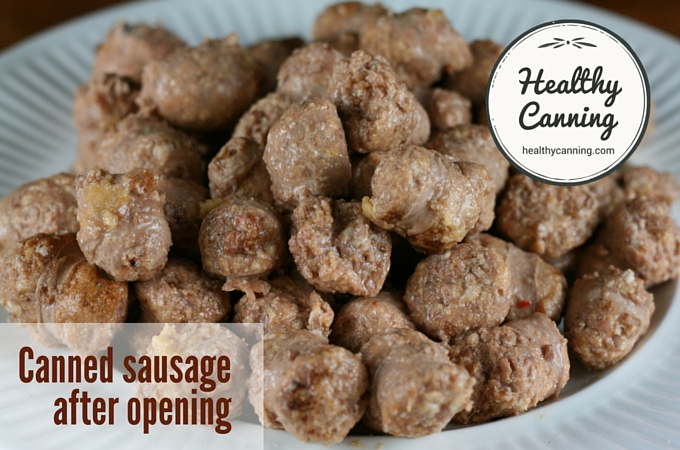
This is what your canned sausage will look like after it is opened, and drained.
When you go to use canned sausage, drain it. It will be soft and pale, though some of the browning you did will remain.
If you wish to crisp it back up, just turn it into a hot frying pan (lightly sprayed or with a bit of oil) for 3 to 5 minutes, stirring frequently. It will look like the sausage pieces in the picture below.
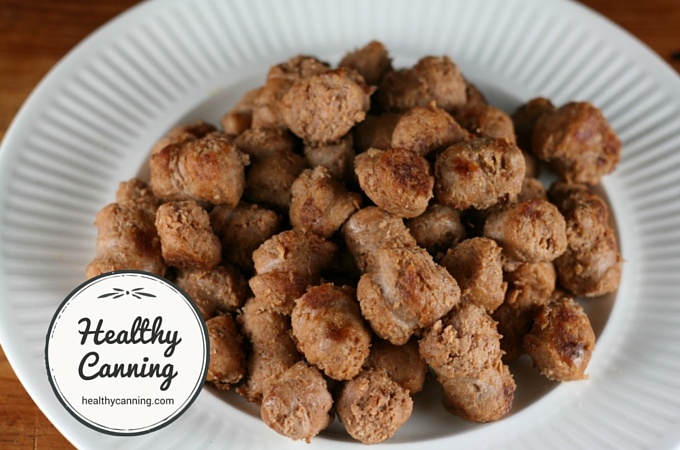
This sausage was re-crisped after opening in a lightly-sprayed frying pan for about 5 minutes.
Recipes for cooking with home canned sausage
Nutrition
Will vary based on sausage meat used.
Source
Ground or Chopped Meat: Bear, Beef, Lamb, Pork, Sausage, Veal, Venison. United States Department of Agriculture (USDA). Complete guide to home canning. Agriculture information bulletin No. 539. 2015. Page 5-6.
Pork Sausage. In: Ball Blue Book Guide to Preserving. Daleville, Indiana: Hearthmark LLC. Edition 36. 2013. Page 60.
Pork Sausage. In: Bernardin Guide to Home Preserving. Toronto, Canada: Bernardin Ltd. 2013. Page 100.
References

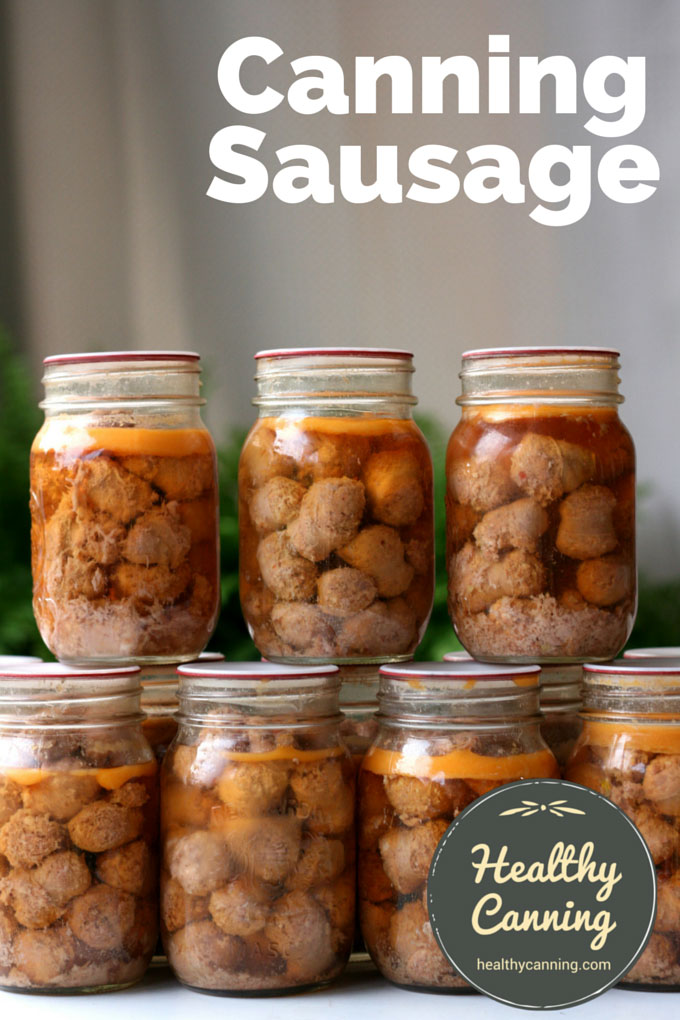
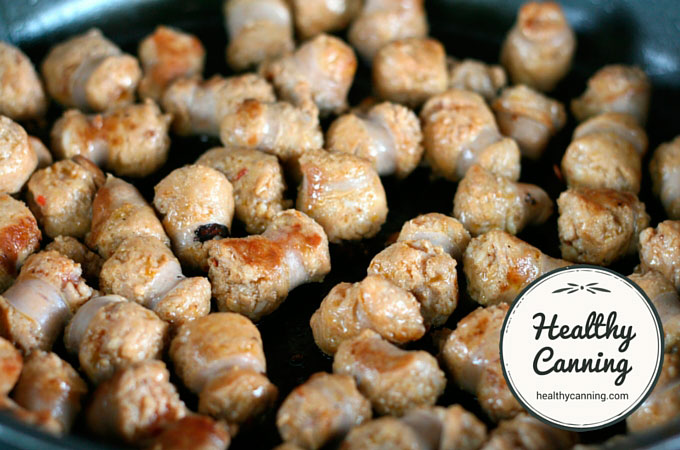
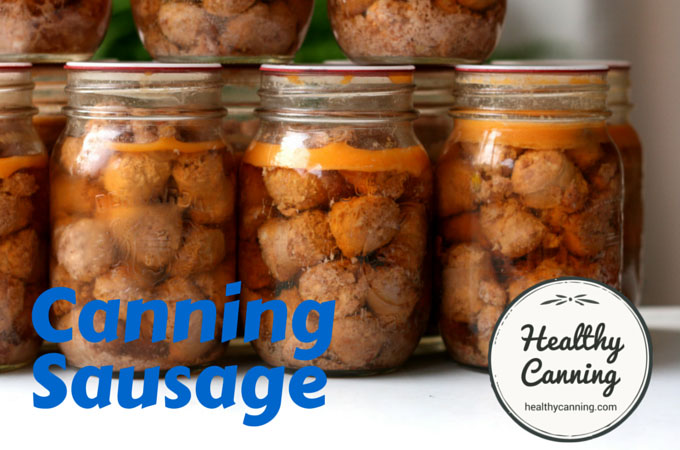
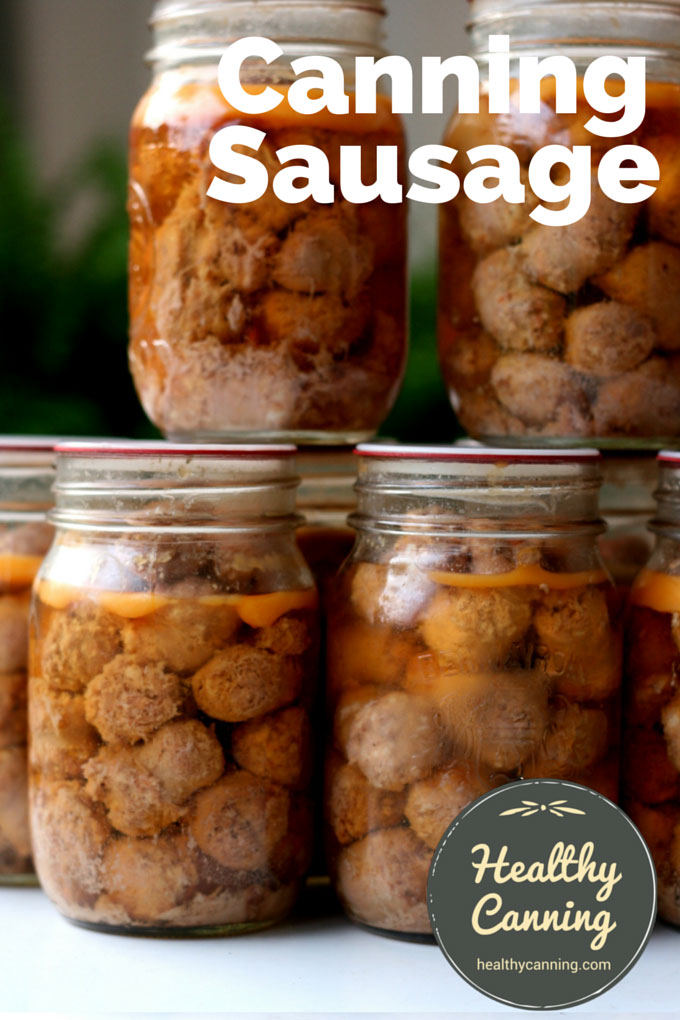
Amanda
Sausages typically contain rice flour, tapioca starch and/or other binders. I understood it was not recommended to put these in the pressure canner as it changes heat distribution. Both yourself and NCHFP provide safe canning recipes for sausages but I can’t find anywhere that clarifies that these sausages must be just made of meat and herbs with no fillers and binders. Please could you let me know if the typical store bought sausages with rice flour etc in them is okay to pressure can safely! Thank you.
Mark
Amanda, I have the same concerns. Plenty sausage canning advice out there but everyone just considers it the same as meat. Many sausages have protein binders in them containing non-fat powdered milk, heavy cream or raw egg. None of these should be pressure canned due to botulism risks.
Currently preparing to make my own sausages using a carrot protein binder (C-Bind) so they’re pressure canning safe (?).
Mark
Amanda, It’s worse than you think. Many commercially produced sausages use powdered milk, heavy cream or egg as binders. These are all items I’ve been told should never be canned. They show up on the ingredient list under “natural flavors” so there’s no way of knowing what’s in the sausage.
I think the USDA guidelines for sausage are very short sighted because they do not take the full ingredients into account. A person could can sausages with cheese chunks and still be completely within the guidelines, but nowhere near safe.
I am a home canner and a sausage maker, working on food safe sausage recipes for canning.
John Yurrick
Could I mix a little flour and maybe egg to my sausage before canning to make it hold it’s shape? I want to form wiener shaped sausages that will come to about an inch from the top of my pints, and then add some spices in the jar before canning.
Ellen
Is it safe to can the sausage in the refrigerator section such as polish sausage packed in a giant link? It is not shelf stable, but it is not what I think of when someone says link sausage.
Thank you!
Healthy Canning
Good question Ellen. In North America, when people say “Polish sausage” they often mean a cured sausage that is ready to eat as a snacking meat. These canning directions are not for cured sausages. (In Poland, “Polish sausage means something very different of course, including fresh sausages and those could be canned using these directions.) In American English “Kielbasa” refers to smoked, cured sausage, whereas in Poland it just means “sausage” (as in, any type of sausage).
Tammy R
Can you can fresh summer sausage with a casing on it.
Janet
No it is not safe considering polish sausage is cured. Only fresh sausage with no additives or curing can be safely canned.
Brenda
Not all Kielbasa is cured. KIOLBASSA brand is uncured and made without MSG, nitrates, gluten free, and milk free. You can check out their website. Some kielbasa companies use dry milk in their products, too. Something else to watch for.
JulieB
When I took the jars out of the canner, 2 of them do not have liquid all the way up covering the sausage. Does this mean it is no good? Or is it fine that way?
Healthy Canning
It is fine. Just put those jars to the front of the shelf and use first, as the exposed sausage in them may darken over time.
Kathryn Lanier
Is this method applicable for sausages like Johnsonville Italian Sausage and Jimmy Dean breakfast sausage? Or does one need to use a Ball type sausage recipe? I am wondering because the NCFHP says use fresh sausage and I wondered if I needed to make one of the recipes from scratch or if the “fresh” refers to a refrigerated commercial sausage versus a smoked sausage…..
Thank you for helping this somewhat inexperienced canner!
Thank you so much!
Healthy Canning
You are correct. Fresh refers to refrigerated, totally raw sausage as opposed to smoked, cured sausages.
Rebecca Morehouse
We have canned sausage for a number of years. It is great for sausage gravy, added to dishes needed for sausage, easy to use. We prefer the canned to frozen.
Desiree j
Do you use water or broth?
Healthy Canning
You may use either.
Lucinda Kinlow
Thank you for sharing how the sausage looks and the texture after you open a jar of pressure canning meat.
Melanie
Hi,
is it safe to add dry herbs and spices to the tomato juice when canning sausages or rather can them in a thin version of a homemade curry-ketchup (as long as the recipe for the ketchup itself is safe for canning)?
I thought about canning sausages “currywurst”-style… ;-D
Thanks for your help!
Healthy Canning
Yes, that would be safe. It’s always safe to tweak the dry seasoning in canning recipes. And a thin spiced tomato juice-like product would be fine.
Wayne
Can I can ground sausage (Italian, or breakfast)?
Deborah Wilkinson
Do you take the outer skin off before browning it
Healthy Canning
The skin can be left on. The USDA directions say, “cut cased sausage into 3- to 4-inch links”. No mention of removing the skin.
Pat
Does anyone know of a pickled pepperoni recipe for canning
Healthy Canning
We don’t know of any tested, guaranteed safe recipes from reputable sources for pickling meat for shelf-stable home-canning. Why not keep the jar in the fridge instead, and be safe?
Barbara D'Angelo
Just wondering what the quality of the meat is afterwards, I have heard people say it was soggy and soft, I make an italian sausage mixing pork and chicken and would like to can whole links in wide mouth pints, but have been dithering on it so far, Making a batch today as soon as the meat defrosts in the fridge.
Healthy Canning
Everyone’s preference is different, but remember as with all things in life, it can often be the few negative people who make their opinions the most well broadcast.
The best thing to do, really, is to can a small amount for yourself and see what the reaction is to the home canned sausage with your audience there at home.
I personally don’t find the inside texture has changed any. Sometimes after opening and draining a jar, I’ll turn the contents into a frying pan with a bit of oil to recrisp and rebrown the outsides for 3 to 4 minutes. It depends how I am going to use them, really.
I put broth from the opened jar in tubs and freeze for future use for soup stock.
Edit: I just want to add one thing. The USDA doesn’t officially have canning recommendations for ground chicken or turkey meat, either alone or in sausage (though So Easy to Preserve, 2014, page 69, does suggest ground turkey in its Spaghetti Sauce with Meat.) I am checking with some Master Food Preservers for you on that point.
Debbie Teachout
Can you use half pint jars? If so how much pound pressure and how long?
Healthy Canning
Hi Debbie, yes you can use half-pint (8 oz / 250 ml) size jars. In fact, that might be a handier size for many people in today’s smaller households. In general, the rule of thumb in tested home canning procedures is that you can go ahead and use smaller-size jars but that you must use the tested processing time for the next largest size up for which a processing time is given. So you would follow the processing directions for the pint (16 oz / 500 ml ) jars, which is 75 minutes at 10 lbs pressure (with the pressure as per usual adjusted for your altitude.) With the smaller size you might get a bit more boiling in the jar, so I would be sure to definitely leave the 1 inch headspace if not 1 1/4 inch (3 cm) to compensate for that. We’ve assembled here on this page for your convenience all the info we found from the experts on using different jar sizes in home canning: https://www.healthycanning.com/jar-sizes/ . Hope that helps.
Rhonda
Can I do this if I don’t have a pressure canner?
Healthy Canning
To can any meat or seafood or low-acid food absolutely requires a pressure canner for shelf-stable storage. If you want to examine alternative storage methods, look into freezing or deyhdration (depending on what it is you want to store.) Cheers!
barb
no